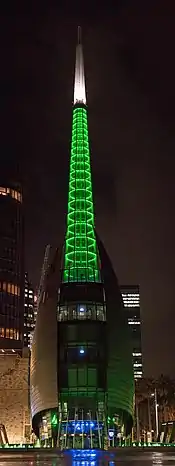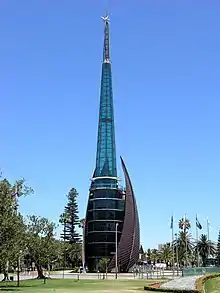
The Swan Bells are a set of 18 bells hanging in a specially built 82.5-metre-high (271 ft) copper and glass campanile in Perth, Western Australia. The tower is commonly known as The Bell Tower or the Swan Bell Tower.[1][2]
Taking their name from the Swan River, which their tower overlooks, and forming a sixteen-bell peal with two extra chromatic notes, they are the second largest set of change ringing bells in the world, the largest being Christ Church Cathedral, Dublin, which has nineteen bells.[3]
Twelve of the set are historic bells from St Martin-in-the-Fields church in Trafalgar Square in London; six others, cast in recent times by the Whitechapel Bell Foundry, round off the set. The St Martin-in-the-Fields bells were donated to the State of Western Australia as part of the 1988 Australian bicentenary celebrations; the additional bells were cast with a subsequent donation of metals mined in Western Australia. The six newer bells include five that were presented to the University of Western Australia, the City of Perth and to the people of Western Australia by the City of London, the City of Westminster and a consortium of British and Australian mining companies, and one bell commissioned by the Western Australian Government.
History of the St Martin-in-the-Fields bells
The St Martin-in-the-Fields bells can be traced to before the 14th century. They were recast in the 16th century by order of Queen Elizabeth I and again between 1725 and 1770 by members of the Rudhall family of bell founders from Gloucester.[4] Due to be recast leading up to 1870 instead they were tuned and restored at London's Whitechapel Bell Foundry and donated to Western Australia, on the initiative of local bellringer and businessman Laith Reynolds. They are rare in that they are one of the few sets of royal bells, and more so since they are the only set known to have left England. The bells are also known to have rung as the explorer James Cook set sail on the voyage in which he reached Australia.
| Bell specifications | |||
|---|---|---|---|
| Bell number | Weight (kg) |
Note | Casting date |
| Treble | 241 | D# | 1998 |
| 2 | 238 | C# | 1988 |
| 3 | 263 | B# | 1988 |
| Flat 3 | 261 | B | 1988 |
| 4 | 254 | A# | 1988 |
| 5 | 279 | G# | 1758 |
| 6 | 263 | F# | 1770 |
| 7 | 284 | E# | 1758 |
| 8 | 300 | D# | 1725 |
| 9 | 370 | C# | 1725 |
| 10 | 390 | B# | 1725 |
| Flat 10 | 453 | B | 1988 |
| 11 | 486 | A# | 1725 |
| 12 | 589 | G# | 1725 |
| 13 | 728 | F# | 1725 |
| 14 | 831 | E# | 1725 |
| 15 | 1,088 | D# | 1726 |
| Tenor | 1,480 | C# | 1726 |
The bell tower
The tower was designed by the local architects Hames Sharley. The 18 bells have a combined weight of about 9 tonnes (20,000 lb) and, when rung, exert considerable forces on the support structure. To achieve the required rigidity, the six-story bell chamber was made with reinforced concrete cast in situ. The bell chamber was designed by the structural engineering firm Arup.
Soundproof louvres and doors are used to muffle the sound or direct the noise towards the city or the river as required. The glass-clad spire is designed using spokes that radiate horizontally from a centrally positioned axle, declining in width as it rises to a point. The solid-steel columns of the spire are rectangular and the concrete bell chamber is enveloped in 30-metre-high (98 ft) copper sails and glass.
The redeveloped Barrack Square along Barrack Street precinct, which surrounds the tower, includes reflection pools as well as cafes, restaurants, shops and cycling and walking paths.
An inlaid path made of ceramic tiles initially surrounded the tower, with each tile consisting of a list of some of the youngest and oldest cohorts of students from nearly every school in Western Australia from 1999, arranged alphabetically by school name. As of March 2014, the tiles were removed as part of the Elizabeth Quay project, but have since been reinstalled in a new artwork to the east of the tower.[5][6]
In 2018, to commemorate the centenary of the World War One armistice on 11 November, a large 6.5 tonnes (14,000 lb) bell was cast by VEEM Limited, Canning Vale. Unlike the other bells in the tower, this is swung electronically using a motor, supplied by a Belgian firm. It is known as the "Great ANZAC Bell".[7]
Since 2013 the area around Barrack Street Jetty has under gone redeveloped; this included removal of part of the reflecting pool and creation of a boardwalk in front of the Bell Tower. The work is part of a larger foreshore project that also incorporates the Elizabeth Quay development.[8][9]
Controversy
The A$5.5 million building was said to be built to commemorate the new millennium, but at the time the government and the Premier of Western Australia, Richard Court, received a fair amount of criticism from locals who opposed it, calling it a wasteful expenditure. However, it remains one of the only "icon" millennium projects that came in on time, on budget and is still open.
Gallery
 The tower as seen from Barrack Street at dusk
The tower as seen from Barrack Street at dusk.jpg.webp)

.jpg.webp)
.jpg.webp)
.jpg.webp)
 Fountains in front of Swan Bells
Fountains in front of Swan Bells The Swan Bells
The Swan Bells
See also
References
- ↑ "The Bell Tower". Western Australian Tourism Commission. Retrieved 1 January 2015.
- ↑ Swan Bell Tower – www.LookAtWA.com.au. Retrieved 11 October 2011.
- ↑ "Visiting".
- ↑ Perth, The Bell Tower (Swan Bells), Dove's Guide for Church Bell Ringers. Retrieved 2008-07-17
- ↑ Ken Acott (28 March 2014). "Bell tolls for quay signatures". The West Australian. Retrieved 29 March 2014.
- ↑ "Signatures a thing of the past". Mandurah Mail. 28 March 2014. Retrieved 29 March 2014.
- ↑ Andrew Reynolds (10 November 2018), Great ANZAC Bell, Swan Bells, Perth, archived from the original on 21 December 2021, retrieved 18 November 2018
- ↑ "Elizabeth Quay inlet set to take shape - News - Australian Tenders". australiantenders.com.au. Retrieved 24 June 2020.
- ↑ "Draft Perth Water Buneenboro Precinct Plan" (PDF). Department of Biodiversity, Conservation and Attractions. Retrieved 24 June 2020.
External links
- Official website

- The Bell Tower at the Department of Culture and the Arts
- The Swan Bells - Perth, Australia, at http://archiloverz.org/